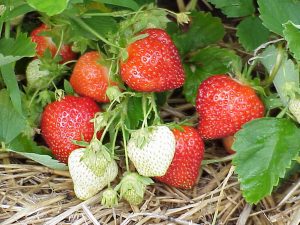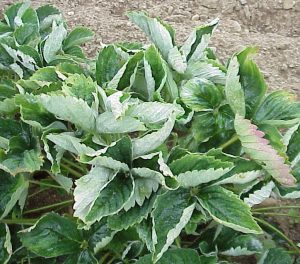Strawberry IPM Newsletter No. 5 – June 15, 2018
 Strawberry IPM Newsletter No. 5 – June 15, 2018
Strawberry IPM Newsletter No. 5 – June 15, 2018
Click on photos to enlarge.
HARVEST BEGINS IN SOUTHERN MAINE
Birds Causing Damage on Early Ripening Fruit
Situation:
Strawberry fields have been opening up in southern Maine this week, with growers hoping for a good weekend. The crop looks very good, although the lack of rain this spring may be having an impact on fruit size. Cedar waxwings have been a problem in many fields, pecking and feeding on the first ripe fruit. Hopefully, once pickers start to frequent the fields these birds will cause less damage, but they are very bold and hard to deter (see last week’s issue for more details on managing birds). The Strawberry IPM Newsletter will take the next couple of weeks off and return with the annual renovation issue in July.
Tarnished plant bug populations remain low, with most fields not having any nymphs, but two coastal fields were over the spray threshold of 4 or more flower clusters infested per 30 sampled. Thus, growers should continue scouting for tarnished plant bug, especially in later ripening varieties, until the green fruit start to swell.

Sap beetles: Growers should keep an eye out for sap beetle damage as the berries start to ripen. The 1/8 inch-long, dark brown beetles chew small holes in ripening fruit, similar to slug injury. They may be found in the holes they’ve chewed, but often drop to the ground when disturbed. The best management strategy for sap beetles is good sanitation. Keep the field free of overripe fruit by picking often and thoroughly. Insecticide sprays for this pest can be effective, but should be a last resort during the harvest period. Assail®, Brigade®, Dibrom® and PyGanic® are registered for control of sap beetles with pre-harvest intervals ranging from 12 to 24 hours. Read the product label carefully for this and other application instructions and restrictions.
Two-spotted spider mite: Although we are finding mites in many of the fields we are scouting, most fall below the control threshold of 25% of leaves being infested. If dry weather continues to dominate, mites will likely continue to be a problem in strawberries. However, bed renovation just after harvest and the few weeks following are a good time to manage mites, as both miticides and/or predatory mites can be very effective then.

Diseases: Once the strawberries are beyond the bloom stage, fungicide applications for gray mold can usually be stopped for the season, unless there are a lot of rainy days as the fruit progress toward harvest. Keep an eye out for brown patches or spots developing on the fruit, especially around the calyxes, that could indicate an early gray mold infection.
Powdery mildew: We’re starting to see some early indications of powdery mildew. Look for upward cupping of the leaves and reddish streaking or lesions on the leaf and flower stems. Consider using a fungicide that will control powdery mildew, such as captan + Topsin-M®, or Pristine® if you’re still spraying for gray mold. Those very close to harvest may want to wait until renovation after harvest to initiate a control program.
Annual Pre-Harvest Checklist for Pick-Your-Own
It’s that time again! As harvest approaches make sure that your farm is ready to provide your customers with the best possible picking experience. Take our annual review below to evaluate your customer readiness.
- Your phone message and web/Facebook pages with picking conditions and opening and closing times are regularly updated.
- Signs to the farm are neat and easy to read.
- There is easy access to the fields and plenty of parking.
- Someone is ready to greet customers and offer parking instructions and directions to the field.
- Access to the field is free of hazards.
- Transportation is provided for the elderly and disabled.
- The rules regarding picking are clearly posted.
- Someone is in the field to show customers where to pick and to answer questions.
- There are plenty of picking containers available.
- Clean restroom and hand washing facilities are available.
- Someone is available to help customers carry fruit out of the field.
- The checkouts are fast and efficient.
- Beverages are available.
- Shade and seats are available for customers wanting to rest.
- The help are friendly and knowledgeable.
A friendly, clean, and organized atmosphere will leave a lasting impression on your customers, encouraging them to come back and to recommend your farm to their friends.
Hold the Date!
Maine State Pomological Society Summer Tour on Wednesday July 18, 2018, at Dole’s Orchard in Limington.
Earl and Nancy Bunting will be hosting the Maine State Pomological Society Summer Tour at their farm this summer. Much of the focus will be on the tree fruit grown at Dole’s orchard, including apples and cherries, but there are also large plantings of pick-your-own strawberries, raspberries and blueberries. Some of the fruit is also contracted to a local brewery. There will be a morning educational program, including talks from research and Extension Specialists, followed by lunch and afternoon tours of the fields and orchards led by Earl and Nancy. Plan to come visit this beautiful farm with us! Pre-registration is requested so we know how many lunches to request. Please contact Renae Moran or Pam St. Peter at 207.933.2100 or pamela.stpeter@maine.edu for more information.
Sincerely,
David T. Handley
Vegetable and Small Fruit Specialist
Highmoor Farm, P.O. Box 179, 52 US Route 202, Monmouth, ME 04259, 207.933.2100
UMaine Extension Diagnostic Research Lab, Pest Management Unit, 17 Godfrey Drive, Orono, ME 04473, 1.800.287.0279
Where brand names or company names are used it is for the reader’s information. No endorsement is implied nor is any discrimination intended against other products with similar ingredients. Always consult product labels for rates, application instructions and safety precautions. Users of these products assume all associated risks.
The University of Maine is an equal opportunity/affirmative action institution.
